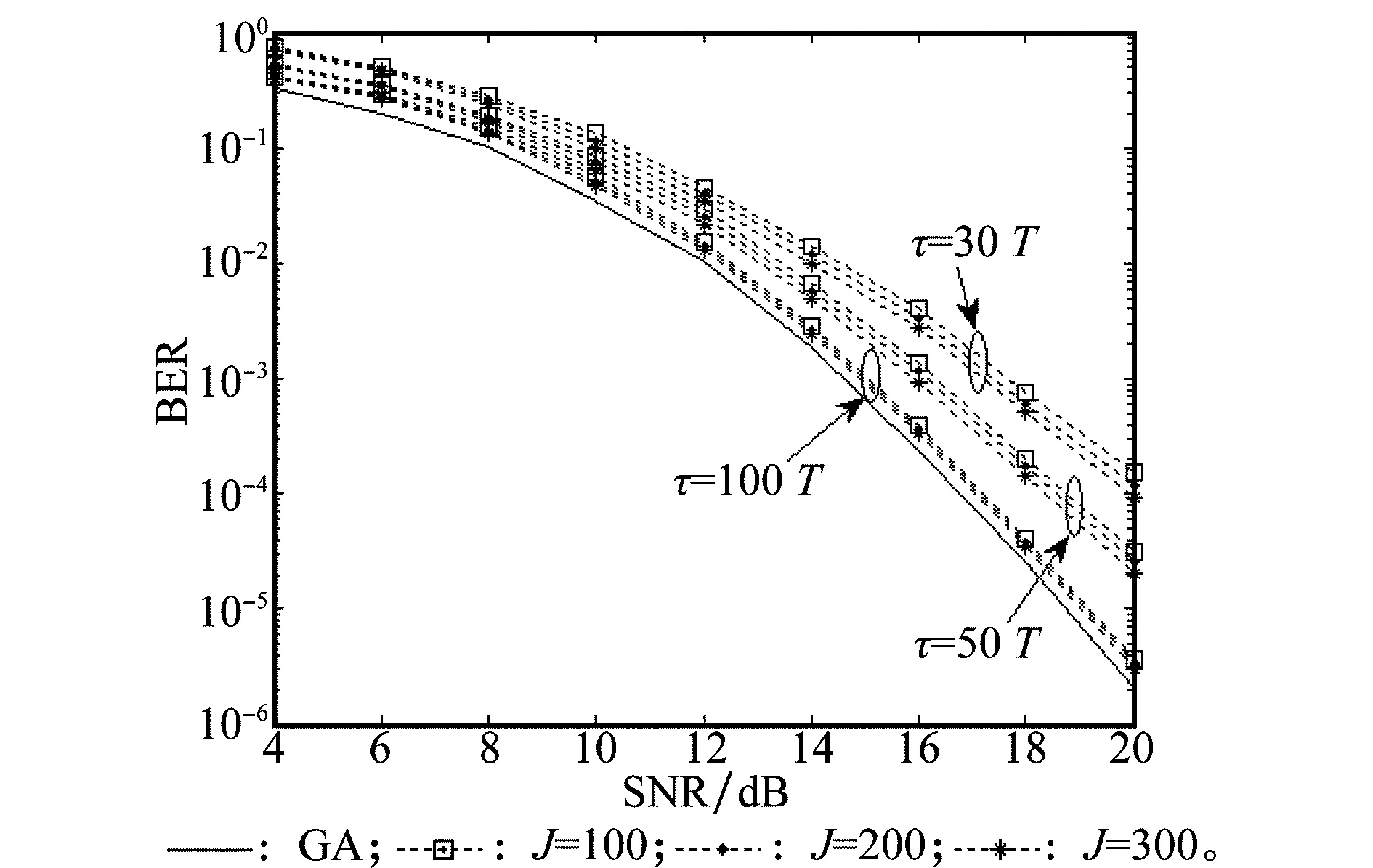基于AF-CDC-OFDM的差分网络编码
李民政, 欧阳缮, 谢跃雷, 肖海林
(1. 桂林电子科技大学广西信息科学实验中心, 广西 桂林 541004;
2. 西安电子科技大学电子工程学院, 陕西 西安 710071)
基于AF-CDC-OFDM的差分网络编码
李民政1,2, 欧阳缮1, 谢跃雷1, 肖海林1
(1. 桂林电子科技大学广西信息科学实验中心, 广西 桂林 541004;
2. 西安电子科技大学电子工程学院, 陕西 西安 710071)
摘要:在多子载波、频率选择性衰落、双向中继转发信道中提出多中继协作的基于AF-CDC-OFDM的差分网络编码方法。通过多个协作中继的分布式循环延时编码及功率放大处理,两路终端发送的差分编码分组可获得完全的协作分集和频率分集增益。两路终端在检测对方的发送信号之前需要消除自干扰信号,为此,提出基于统计相关的自干扰分量估计方法。仿真结果表明,提出的差分网络编码能够获得完全的分集增益性能,对应的自干扰分量相关统计估计算法在慢衰落信道中与干扰分量完全消除的检测性能相比,仅有0.5 dB的信噪比损耗。
关键词:差分网络编码; 循环延时编码; 放大转发
0引言
虽然双向中继信道(two way relay channel, TWRC)中物理层网络编码(physical network codes, PNC)提高了传输效率,但相干检测使PNC所需的信道估计开销更大,挑战更高[1-4]。在此情况下,差分网络编码成为更现实的选择。基于解码转发(decode and forward, DF)的差分网络编码对中继而言接收的是双向叠加信号,当双向发送符号和信道状态信息(channel status information,CSI)均不可知时,可通过双向CSI的二阶矩构建中继检测方法,以此完成双向接收信号的检测和差分网络编码的实施[5-6]。其缺点是中继检测复杂度高、处理环节繁杂、开销大。为此,文献[7-9]提出了基于模拟网络编码(analog network codes,ANC)的差分编码方案,中继仅需放大转发(amplify and forward, AF)双向叠加信号,以此保障两路终端能有效接收转发信号。这种编码方法可有效降低中继的处理复杂度,两路终端在消除自干扰分量后,能够以传统差分检测方法得到对方的发送信息。文献[10-13]结合最佳中继选择策略提出了可获得高分集增益的差分ANC方案。文献[14-15]提出了基于ANC的差分空时编码方法,获得了完全的协作分集增益。然而,快衰落、多中继、多子载波通信环境中,结合正交频分复用(orthogonal frequency division multiplexing,OFDM)的差分网络编码研究比较少见,文献[16]提出了平坦衰落信道中结合OFDM和循环延时编码(cyclic delay codes,CDC)的差分ANC方案,但两路终端的差分检测仍然需要知道自身到中继的CSI,因此,这种差分网络编码并非完全的差分检测,也只能获得协作分集增益。
本文提出适用于频率选择性衰落信道的基于AF-CDC-OFDM的差分网络编码,通过多个协作中继对双向叠加信号进行CDC和AF处理,使两路终端的编码分组可获取完全的协作和频率分集增益。其理想检测的前提是两路终端自干扰分量完全消除,为此,提出基于统计相关的自干扰分量估计和消除方法。理论分析和仿真结果表明,提出的差分网络编码能获得相应的分集性能,对应的自干扰分量相关统计估计算法在慢衰落信道中是有效的。
1差分网络编码模型


图1 基于AF-CDC-OFDM的差分网络编码模型
2差分网络编码方法

(1)

(2)

(3)

(4)

(5)

(6)

(7)

(8)
(9)

3误码性能分析

(10)

(11)

(12)

(13)

(14)

(15)

(16)
式中,|hf(l)|2(l=1,…,KL2)为独立同分布的指数随机变量,因此,式(16)可表示为
(17)

(18)

4仿真实验与性能分析

图2为基于AF-CDC-OFDM差分网络编码在协作中继个数K=1, 2, 3, 4时,通过仿真获得的终端T1(或T2)的BER性能。同时,为了验证提出的自干扰分量估计(self interference component elimination,SICE)算法的有效性,图中还给出完全消除自干扰分量(genie-aided,GA)后的BER性能。
从图2可看出,随着协作中继个数K的增加,基于AF-CDC-OFDM的差分网络编码BER性能逐渐改善,分集增益也相应增加,当BER为10-4时,对应中继个数K=2,3,4处的信噪比(signal-to-noise ratio, SNR)分别为20 dB,17 dB,15 dB,BER性能依次改善了约3 dB和2 dB,这与理论分析所能获得KL1(或KL2)阶分集增益的结论相一致,也表明提出的差分网络编码能够获得完全的协作和频率分集性能;协作中继个数K相同时,提出的SICE方法与GA相比,BER性能相同时,SNR约有0.5 dB的损耗,这表明在慢衰落信道中提出的SICE算法能有效估计和消除自干扰分量。

图2 中继个数K=1, 2, 3, 4时的BER
图3为SICE算法在时变特性逐渐增强的信道中获取的BER性能,仿真中对应的信道相干时间分别为τ=100T、50T、30T,协作中继个数K=3,自干扰分量估计统计所需的OFDM帧符号个数分别为J=100、200、300。

图3 信道相干时间τ=100T、50T、30T时的BER
从图3可以看出,随着信道时变特性的增强及信道相干时间τ的降低,提出的SICE算法与GA方法相比,对应的BER性能呈下降趋势,即使自干扰分量估计所需的OFDM帧符号数J由100增加到300,SICE算法的BER性能也未有明显改善。当BER性能为10-3时,GA方法所需要的SNR为15 dB,提出的SICE算法在τ=100时与GA略差0.5 dB,在τ=50时与GA略差2 dB,在τ=30时与GA略差4 dB,这表明随着信道时变特性的加剧,通过SICE算法得到的自干扰分量的估计误差会相应增加。如何在快衰落信道中更好地估计和消除自干扰分量尚需要进一步研究。
5结论
在多子载波、频率选择性衰落、双向中继转发信道中提出多中继协作的基于AF-CDC-OFDM的差分网络编码方法。通过多个协作中继的分布式循环延时编码及功率放大处理,双向终端发送的差分编码分组可获得完全的协作分集和频率分集增益。双向终端在检测对方的发送信号之前需要消除自身干扰信号,为此,提出基于相关统计的自干扰分量估计消除方法。仿真结果表明,提出差分网络编码能获得相应的分集性能,提出的自干扰分量相关统计估计消除算法在慢衰落信道中是有效的。
参考文献:
[1] Fang Z X, Liang F, Li L P. Performance analysis and power allocation for two-way amplify-and-forward relaying with generalized differential modulation[J].IEEETrans.onVehicularTechnology, 2014, 63(2): 937-942.
[2] Tian J G, Zhang Q, Yu F Q. Non-coherent detection for two-way cooperative communications in fast rayleigh fading channels[J].IEEETrans.onCommunications,2011,59(10):798-801.
[3] Cui T, Gao F F, Ho T. Distributed space time coding for two-way wireless relay networks[J].IEEETrans.onSignalProcessing, 2009, 57(2): 658-671.
[4] Bagheri S, Verde F, Darsena D. Randomized decode-and-forward strtegeies for two-way relay networks[J].IEEETrans.onWirelessCommunications, 2011, 10(12): 4212-4225.
[5] Cui T, Gao F, Tellambura C. Differential modulation for two-way wireless communications: a perspective of differential network coding at the physical layer[J].IEEETrans.onCommunications, 2009, 57(10): 2977-2987.
[6] Guan W, Liu K J R. Performance analysis of two-way relaying with non-coherent differential modulation[J].IEEETrans.onWirelessCommunications, 2011, 10(6): 2004-2014.
[7] Song L, Li Y, Huang A, et al. Differential modulation for bidirectional relaying with analog network coding[J].IEEETrans.onSignalProcessing, 2010, 58(7): 3933-3938.
[8] Valenti M C, Torrieri D, Ferrett T. Noncoherent physical-layer network coding with FSK modulation: relay receiver design issues[J].IEEETrans.onCommunications,2011,59(9):2595-2604.
[9] Huo Q, Song L, Li Y, et al. A distributed differential space-time coding scheme with analog network coding in two-way relay networks[J].IEEETrans.onSignalProcessing, 2012, 60(9): 4998-5004.
[10] Li Y, Louie R H Y, Vucetic B. Relay selection with network coding in two-way relay channels[J].IEEETrans.onVehicularTechnology, 2010, 59(9): 4489-4499.
[11] Krikidis I. Relay selection for two-way relay channels with MABC DF: a diversity perspective[J].IEEETrans.onVehicularTechnology, 2010, 59(9): 4620-4628.
[12] Song L, Hong G, Jiao B, et al. Joint relay selection and analog network coding using differential modulation in two-way relay channels[J].IEEETrans.onVehicularTechnology, 2010, 59(6): 2932-2939.
[13] Zhou Q F, Li Y H, Lau C M. Decode-and-forward two-way relaying with network coding and opportunistic relay selection[J].IEEETrans.onCommunications, 2010, 58(11): 3070-3076.
[14] Ma S, Zhang J K. Noncoherent diagonal distributed space-time block codes for amplify-and-forward half-duplex cooperative relay channels[J].IEEETrans.onVehicularTechnology, 2011, 60(5): 2400-2405.
[15] Alabed S J, Paredes J M, Gershman A B. A simple distributed space-time coded strategy for two-way relay channels[J].IEEETrans.onWirelessCommunications,2012,11(4):1260-1265.
[16] Xu J, Zhu S, Gao Z. Partial-differential distributed cyclic delay diversity for nonregenerative two-way relaying system[J].IEEESignalProcessingLetters, 2009, 16(7): 596-599.
[17] Bauch G. Differential modulation and cyclic delay diversity in orthogonal frequency-division multiplex[J].IEEETrans.onCommunications, 2006, 54(5): 798-801.
[18] Liu Z, Giannakis G B. Block differentially encoded OFDM with maximum multipath diversity[J].IEEETrans.onWirelessCommunications, 2003, 2(3): 420-423.
[19] Hochwald B M, Sweldens W. Differential unitary space-time modulation[J].IEEETrans.onCommunications,2000,48(12):2041-2052.
[20] Jeffrey A,Zwillinger D.Tableofintegrals,series,andproducts[M].6th ed.New York:Academic Press,2000.
李民政(1972-),男,副教授,博士,主要研究方向为协作分集编码与网络编码。
E-mail:minzhengli@126.com
欧阳缮(1960-),男,教授,博士,主要研究方向为阵列信号处理。
E-mail:hmoyshan@guet.edu.cn
谢越雷(1974-),男,副教授,硕士,主要研究方向为通信信号及阵列信号处理。
E-mail:ylxie_guet@126.com
肖海林(1976-),男,教授,博士,主要研究方向为移动通信与个人通信。
E-mail:hailinxiao@guet.edu.cn

网络优先出版地址:http://www.cnki.net/kcms/detail/11.2422.TN.20150104.1720.009.html
AF-CDC-OFDM based differential network coding
LI Min-zheng1,2, OUYANG Shan1, XIE Yue-lei1, XIAO Hai-lin1
(1.GuangxiExperimentCenterofInformationScience,GuilinUniversityofElectronicTechnology,
Guilin541004,China; 2.SchoolofElectronicEngineering,XidianUniversity,Xi’an710071,China)
Abstract:Based on the amplify and forward-cylic delay codes-orthogonal frequency division multiplexing (AF-CDC-OFDM) technology, a differential network coding method with multi-relay cooperation is proposed over the multi-carrier and frequency selective two-way relay channel. The two-way terminals can obtain the maximum cooperation diversity gains and frequency diversity gains through the distributed relay cyclic delay coding and power amplification processing. However, the two terminals need to eliminate the self-interference component among received signals before detecting the transmit symbol. Therefore, a self-interference elimination method is proposed with correlation statistical processing. The simulation results demonstrate that the proposed differential network encoding method can obtain the full diversity gain, and the proposed self-interference component eliminating method only has 0.5 dB SNR loss compared with the Genie-aided method over the slow fading channel.
Keywords:differential network coding; cyclic delay codes (CDC); amplify and forward (AF)
作者简介:
中图分类号:TN 925
文献标志码:A
DOI:10.3969/j.issn.1001-506X.2015.07.29
基金项目:国家自然科学基金(61362007,61371186,61261018,61461015);广西可信软件重点实验室基金(KX201414);广西自然科学基金(2013GXNSFFA019004,2014GXNSFAA118399,2014GXNSFGA118007);广西教育厅重点项目(ZD2014052)资助课题
收稿日期:2014-07-18;修回日期:2014-11-23;网络优先出版日期:2015-01-04。

